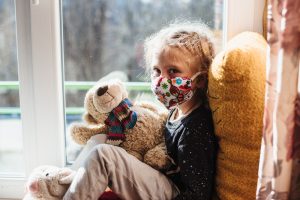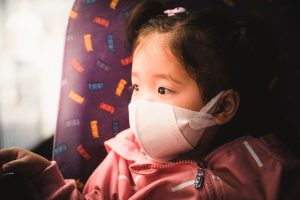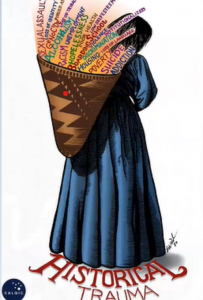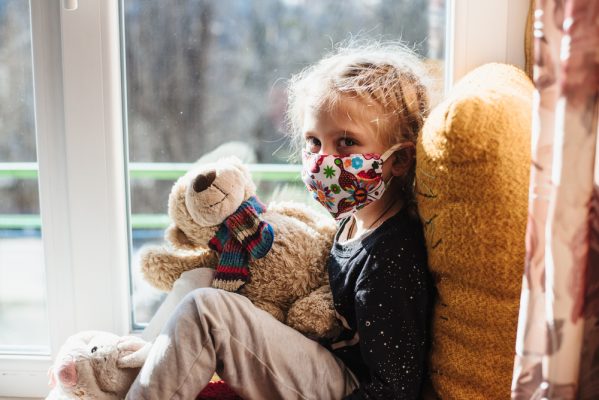Last March, as we launched CALQIC, a statewide learning collaborative integrating screening and response for adverse childhood experiences (ACEs) with the UCSF Center to Advance Trauma-Informed Care, the world was about to turn upside down.
 “We had no idea what was in store,” recalled Megan O’Brien, program director at the Center for Care Innovations (CCI). “Just the day before, the World Health Organization had declared COVID-19 a global pandemic,” and CCI’s annual retreat had been cancelled. O’Brien didn’t know it then, but the quick informational webinar on CALQIC she led in CCI’s downtown Oakland on March 12 would be the last day she would set foot in the office that year. Nor did she and others know that CCI would be unable to hold its popular in-person peer learning sessions, coaching and site visits – the “secret sauce” it attributed to program success – for the next twelve months.
“We had no idea what was in store,” recalled Megan O’Brien, program director at the Center for Care Innovations (CCI). “Just the day before, the World Health Organization had declared COVID-19 a global pandemic,” and CCI’s annual retreat had been cancelled. O’Brien didn’t know it then, but the quick informational webinar on CALQIC she led in CCI’s downtown Oakland on March 12 would be the last day she would set foot in the office that year. Nor did she and others know that CCI would be unable to hold its popular in-person peer learning sessions, coaching and site visits – the “secret sauce” it attributed to program success – for the next twelve months.
Like the CALQIC clinics, CCI raced to move its work online, including all in-person sessions with members of the far-flung learning collaborative. Clinics began preparing for ACEs screening and/or expansion, only to be subsumed by COVID-19 testing and treatment, as well as floods, wildfires, and a movement for racial injustice in the wake of the George Floyd killing. This March 16, a year and a day after California Governor Gavin Newsom declared a statewide COVID-19 lockdown – and halfway through the CALQIC initiative — CCI and UCSF hosted an online gathering to share and celebrate what participants had learned amid the chaos, tragedy, exhaustion, and heroism of the pandemic era.
“Thank you for accompanying us on this journey and for doing the work under such tough circumstances,” O’Brien told the CALQIC participants, noting that it was natural that some had to put their innovation strategies on hold. “We ourselves tried some things that worked well, some that worked okay, and others that utterly failed…It hasn’t been easy, and we’re not through the most challenging part yet.” As Dr. Alicia Lieberman, a professor, researcher and author who directs the Child Trauma Research Center at UCSF, said at a recent CALQIC session, ‘We need to remember that self-care is essential to remain effective. We also need to remember there’s a crack in everything, and mistakes can be repaired. That we are all learning together.’”
 Dr. Anda Kuo, UCSF co-director of CALQIC, echoed these sentiments. “Many of us have been feeling overwhelmed, deeply sad, tired, and hopeful all at once,” she told participants. “In this space of multiple mass trauma, it’s not just that you’ve been resilient and persistent, but you’ve also been leaders — flexible and innovative in finding alternative solutions for connections with patients, families and communities while screening and responding to ACEs and trauma. And many of these alternative solutions will remain way past this unprecedented historical time.” Kuo added that this work reminded her of a quote she had encountered by John Gardner, who once said: “We are continually faced with a series of great opportunities, brilliantly disguised as insoluble problems.”
Dr. Anda Kuo, UCSF co-director of CALQIC, echoed these sentiments. “Many of us have been feeling overwhelmed, deeply sad, tired, and hopeful all at once,” she told participants. “In this space of multiple mass trauma, it’s not just that you’ve been resilient and persistent, but you’ve also been leaders — flexible and innovative in finding alternative solutions for connections with patients, families and communities while screening and responding to ACEs and trauma. And many of these alternative solutions will remain way past this unprecedented historical time.” Kuo added that this work reminded her of a quote she had encountered by John Gardner, who once said: “We are continually faced with a series of great opportunities, brilliantly disguised as insoluble problems.”
After an evaluation update and a moment of meditation, the health care teams took the stage. Fifteen CALQIC organizations – some of whom have been working to crack the case on seemingly insoluble problems involving ACEs work – moved into breakout rooms to present their storyboards and data on the progress they had made. Here are a few of the most important learnings from the session.
10 Key Takeaways
1. Be flexible when it comes to ACEs screening workflows.
There was a strong camaraderie and commitment to problem-solving and trauma-informed care among the CALQIC clinics in the Los Angeles County Department of Health Services, the second largest municipal health system in the United States, and the team assumed they would all use the same workflow. “We went in thinking, ‘Oh, we’re going to have a cookie- cutter formula for how our clinics are going to screen,’” said Nina Thompson of the Los Angeles County Department of Health Services. “But as we dove into the implementation, we were surprised to find every clinic works differently and the workflows are very different. So, we’ve had to adapt the screening based on each clinic workflow.”
2. Don’t focus all your attention on just the patients with the highest ACE scores.
Shannon Thyne, director of pediatrics at LACDHS, noted that the department had a plan for the 10 percent of patients with high ACE scores. But the organization also wants to develop a plan on how to best help the other 90 percent of kids and adults with lower ACE scores. “There’s that 10% that needs something big, and we can refer them for behavioral health at a regional center or somewhere else. And then for the other 90 percent, it has to be us,” she said. “And so how do we equalize that?” To begin with, she said, the organization has developed a program called SHARK, which stands for ‘strong, healthy, and resilient kids’” — a youth program that will eventually live in a brick and mortar center.
The other thing LACDHS is doing, Thyne said, is trying to build a network of care using the One Degree platform — the ‘Yelp’ of social services — for referral to social agencies. (See CCI’s case study on another health center’s partnership with One Degree on social needs referrals). “I’m sure others of you have similar platforms such as Unite Us and Aunt Bertha, and we’re trying to really partner with our local First Five and the One Degree platform to help build a network of care,” she said. Rather than just using open-source referral platforms, the clinic seeks to have two-way communication so that if providers send someone to the Boys and Girls Club to enroll in a weight management program, that program will send them back information on their progress. This way, staffers can document patients’ progress in referrals for social needs from everything from weight management to housing and food insecurity.
3. Use ACEs screening to develop stronger relationships with patients.
LACDHS has changed its screening process to being with questions about resilience. During one team meeting, the Olive View-UCLA staff, which includes clerks, nurses, and providers, were asked if, given the chance, would they want to stop or continue ACEs screening. “Unanimously, they said continue,” the clinic report noted. “The most commonly shared reaction was, ‘It helps us better understand our patients and all they have been through.’”
4. Talking about ACES is a good segue to discussing the emotional impact of the pandemic.
 This was true for staffers at the Santa Barbara Neighborhood Clinics. “Santa Barbara is a very beautiful place, and many people probably don’t realize that we have one of the highest rates of children living in [poverty] under challenging conditions,” said Nancy Tillie, chief operating officer, chief financial officer, and project lead. As the team’s report noted, the pandemic year stressed the need “to have a robust integrated health system in place,” so the organization made IT enhancements to accommodate ACEs screening in its Electronic Health Record, retrained all the staff in trauma-informed care, created a template for physician response to ACEs screening, and new referral teams and feedback loops. As the staff conducted online ACEs screenings and referrals, “many providers have found that patients are more open to questions, particularly because this year has been so hard,” according to the team report. “Talking about emotional health and how they are experiencing the effects of the pandemic is a good lead-in to discussing ACEs.”
This was true for staffers at the Santa Barbara Neighborhood Clinics. “Santa Barbara is a very beautiful place, and many people probably don’t realize that we have one of the highest rates of children living in [poverty] under challenging conditions,” said Nancy Tillie, chief operating officer, chief financial officer, and project lead. As the team’s report noted, the pandemic year stressed the need “to have a robust integrated health system in place,” so the organization made IT enhancements to accommodate ACEs screening in its Electronic Health Record, retrained all the staff in trauma-informed care, created a template for physician response to ACEs screening, and new referral teams and feedback loops. As the staff conducted online ACEs screenings and referrals, “many providers have found that patients are more open to questions, particularly because this year has been so hard,” according to the team report. “Talking about emotional health and how they are experiencing the effects of the pandemic is a good lead-in to discussing ACEs.”
5. Burnout is real, so take care of yourself.
When CCI asked CALQIC clinics to describe the two top challenges they are facing in this work, Marin Community Clinics wrote simply, “We are tired,” O’Brien recalled. According to Dr. Heyman Oo, associate site medical director, it was indeed an exhausting and debilitating year. “We’re tired and we had fires and we had to furlough staff,” she said, “so we experienced trauma as an organization. It’s this constant battle of knowing that there’s a lot of work to be done – obviously, we want to take care of our patients and we want to provide them high quality care. But if we’re not taking care of our staff and ourselves, then it all sort of feels flat or falls flat.” Among other things, the clinic has committed to racial equity in terms of professional development and work at home policies affecting providers and staff. (Our CCI story “From Wildfires to Childhood Trauma, a Resilience Collaborative Transformed the Way Clinics Face the Unthinkable” explores how trauma-informed training helped another clinic cope with the floods and wildfires that devastated its community.)
6. Train your entire staff — including front-desk employees — in trauma-informed care.
As Dr. Lieberman noted in another CALQIC meeting, “Everybody can be therapeutic without necessarily being a therapist,” explaining that a front desk person doing the ACES screening, who is often the first point of contact, “is the person who gives patients the message of how much the clinic cares.” This philosophy is in play at Borrego Community Health Foundation, a safety net center for patients in the San Diego side of San Bernardino County. “We want to ensure we have a trauma-informed workforce, so we want to make sure our training includes the security guards and the front desk staff and not just the back end,” says Lucille Aceves, Borrego’s Healthy Steps team lead. “Sometimes patients going through trauma come in, and if the staff is trained, we can ensure we’re not turning them away because of the way they’re acting. We want our clinics to be a safe zone, so that patients know that if they’re going through something, they can come into our clinics and receive the help that they need.” (For more on trauma-informed clinics, see “Widening the Health Care Lens: Takeaways from CALQIC’s Opening Session on Childhood Trauma and Healing”).
7. Expand the reach of your ACEs tools by working with local partners
Family Health Centers of San Diego, for example, has partnered with a local American Academy of Pediatrics chapter, a grantee of ACEs Aware, to translate AAP materials on self-care and resilience and an infographic about protective factors such as the seven domains of wellness. “We’re getting this translated into multiple languages — right now we have it in English and Spanish and we’re finalizing it in Arabic [for our Middle Eastern and North African populations],”said one staffer. “We really love this tool.” These tools will be distributed to families at the health centers.
8. Build on your community’s strengths to promote resiliency and healing.

From the Sonoma County Indian Health Project
“As a tribal program, we really had to spend a lot of time cautiously wondering about how to have our community ready [for screening],” said Alison Whitmore, clinical director and a licensed clinical social worker at the Sonoma County Indian Health Project, which represents six local sovereign nations in Sonoma Country. Since ACEs screening was put on hold when two providers had to return to their families last year due to COVID-19-related reasons, the clinic plans to have leaders from CALQIC and UCSF meet with its leadership team “to build more of a sense of passion and excitement and understanding of what ACEs means in the bigger picture,” Whitmore says. “We want to ready leadership to be able to have conversations with tribal chairs. We’re also building on some resiliency questions with support from a statewide native organization, including questions about historical trauma and health disparity in Indian country. We want to really build the staff’s ability to have conversations about body, mind and spirit and to draw out our own communities’ indigenous knowledge about that. Looking at cultural support and identity-based strengths that people carry with them or that they long for, building deeper connections – that keeps us excited.”
9. It’s often best to start small.
Rolling out a small pilot or cohort can be a good way to conserve resources, especially during a time of upheaval, according to clinicians at Long Valley. During 2020, the clinic was buffeted with storms that left employees without power for a week in two different months, only to confront wildfires during the fall that resulted in employee evacuations. In addition, “COVID-19 closed our doors and we had to move to telehealth, which severely impacted our ability to administer ACEs screens,” said Larann Henderson, a licensed clinical social worker at the clinic. “We don’t have a lot of pediatric patients, so we decided to just stick with adults.” Long Valley scaled back its ACEs screening and response pilot back to include only patients 18 and older with chronic pain, diabetes, and hypertension as well as all adults 18 to 35. This turned out to be especially helpful since the staff needed further ACEs education for the staff to feel comfortable screening.
10. Trauma is the missing piece of the health care puzzle.
Among other things, physician Sara Johnson of the Oakland-based La Clinica de la Raza reported that the clinic was testing customized resilience screeners linked to better health and happiness. “For those of us who haven’t engaged with ACEs before, it’s been profound to do so. It feels like there was a piece of the puzzle that was always missing, and now we can understand. It’s [enhanced] our empathy during COVID. It really made realize our beliefs about our organization – that it’s clunky and too big to change – were wrong. You watch something like this pivot to telehealth, and you think, wow. As my colleague said, it’s an opportunity…and I’m ready for a revolution.”
Find this useful or interesting? We’re constantly sharing stuff like this. Sign up to receive our newsletter to stay in the loop.

